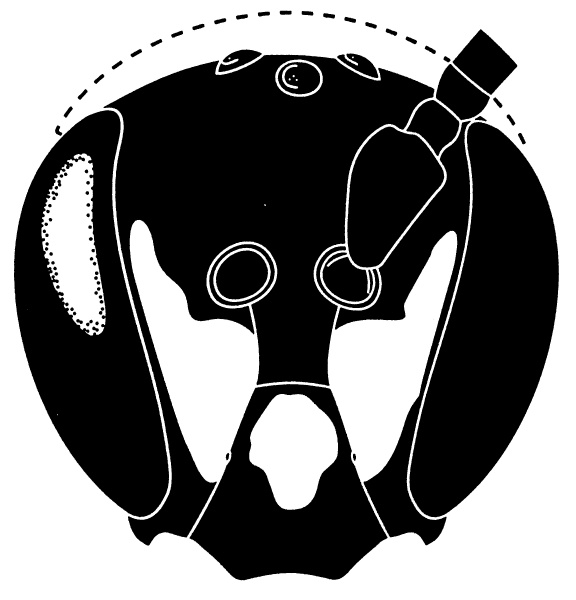Hylaeus in Hawaii

Hylaeus in Hawaii |

|
Hylaeus volatilisIslands: Oahu, Molokai, Lanai, MauiLocations: Maui - (Haleakala NW Slope, Halemauu Trail, Kalahaku, Kalapawili Ridge, Hosmers Grove, Kaluaiki, Kaupo Trail, Kuiki, Laie, Lahainaluna, Lauulu Trail, Oili Puu, Paliku, Puu Keokea, Puu Maile, Supply Trail, Waikamoi, Waikane) Habitats: Coastal to subalpine dry shrubland. Recent collections only from Maui. Plants: Styphelia Xerces: No info. Insects of Hawaii: Medium-sized cleptoparasitic bees with clear to slightly smoky wings and with or without red basal terga. Male face marks variable from no marks to entire lower face yellow (clypeus, supraclypeal area, and paraocular areas) and extended above antennal sockets in narrowing stripe, scape slightly dilated. Female face black or dark reddish, paraocular aras not marked, clypeus emarginate, frons with distinct punctures, fore tarsus with straight hairs. See discussion of cleptoparasites under H. hilaris. Hylaeus volatilis exhibits considerable variation in body size and the pattern of yellow marks. Perkins (1913:lxxix) noted that H. volatilis ranges from coasts to 9000 ft in the mountains. He also observed that cleptoparasites may vary in size according to the size of the hosts provisions and could be exceptionally large when the hosts were large (1913:lxxxi; see also Michener 2000:30). Collections of this species on Haleakala yielded bees ranging in size (wing length) from 4.0 to 5.1 mm and with one male at 3.5 mm. At Haleakala, the common probable hosts are H. difficilis, H. nivicola, H. takumiae, and H. volcanicus, all of which are about the same size. The cleptoparasites in this area exhibit variation in the extent of melanism. Males range from individuals with yellow marks and red basal terga to melanic individuals that are almost entirely dark brown to black. Among 41 males collected during 1991-1997, the faces of 6 (15%) are marked with at least some yellow on the paraocular areas (extended up along the eye in well-defined, narrow stripe above the level of the antennal socket or more frequently reduced to an obscure spot at each side); less commonly also on the clypeus as a central spot; and with the basal 1 to 3 metasomal segments partly red. Intermediate bees (16, or 39%) have the face black or nearly so and with at least the basal metasomal tergum partly red. Melanic bees (19, or 46%) have the face and metasoma black; many retain a small red spot laterally on T1. Regardless of the degree of melanism, males have the following features in common: subglabrous metasomal terga without pubescent margins; basal half of the propodeal area with coarse rugae, mainly linear and longitudinal, with the ground flat and shiny between rugae; apical half of the propodeal area less shiny with finely reticulate rugae; S7 with long lateral processes; median process of the S8 moderately dilated and pubescent at the flexure and the slender apex bifid with short, pubescent tips; and similar male genitalia with long, apical, weakly plumose hair. Among 36 females collected during 1991-1997, 7 (19%) have the clypeus, and rarely also the lower paraocular areas to the level of the antennae, a diffuse red color; the mandibles, scape, and fore tibia (both in frontal view) and up to 3 basal metasomal segments are partly red. Intermediate females (28, or 78%) have the face and scape black or nearly so, reddish fore tibiae, and up to 2 basal metasomal segments red. The single melanic female has only the fore tibiae reddish. All females have an emarginate clypeus, and as in the males, the coarse sculpture on the basal half of the propodeum and subglabrous metasoma. Insects of Hawaii Volume 17 
UH/DOD: Hylaeus near military lands 
Other: |

|